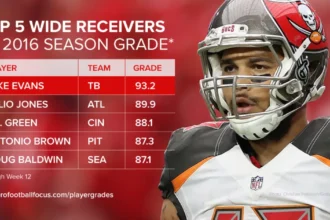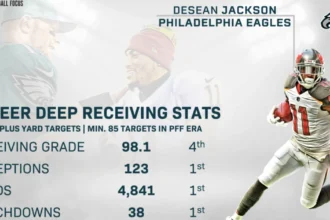The Denver Broncos vs Buffalo Bills Match Player Stats in a thrilling NFL Wild Card playoff game on January 12, 2025, at Highmark Stadium in Orchard Park, New York. The Bills dominated with a final score of 31-7, showcasing their offensive prowess and defensive strength. This article dives deep into the player stats from this matchup, breaking down key performances, team statistics, and what they mean for both teams moving forward. Whether you’re a die-hard fan or new to football, this easy-to-read guide will help you understand the numbers behind the game.
Game Overview: A Tale of Two Teams Denver Broncos vs Buffalo Bills Match Player Stats
The Buffalo Bills, led by MVP candidate Josh Allen, entered the game as the No. 2 seed in the AFC with a 13-4 regular-season record. The Denver Broncos, making their first playoff appearance since their Super Bowl win in 2015, were the No. 7 seed with a 10-7 record. The game started with a spark of hope for Denver, as rookie quarterback Bo Nix connected with wide receiver Troy Franklin for a touchdown on the opening drive. However, the Bills responded with 31 unanswered points, dominating in all three phases of the game.
Let’s break down the player stats and team performances to see how this lopsided result came to be. We’ll cover the quarterbacks, running backs, receivers, and defensive standouts, along with a table summarizing the key stats for easy reference.
Quarterback Performances: Josh Allen Shines, Bo Nix Faces Pressure
Josh Allen (Buffalo Bills)
Josh Allen was the star of the show, delivering a near-flawless performance that solidified his status as one of the NFL’s elite quarterbacks. Allen completed 20 of 26 passes (76.9% completion rate) for 272 yards, throwing two touchdowns and no interceptions. His ability to spread the ball to eight different receivers kept the Broncos’ defense guessing. Allen also added 46 rushing yards on nine carries, picking up five first downs with his legs.
Key moments included a 24-yard touchdown pass to running back Ty Johnson on fourth-and-1 in the third quarter, which extended Buffalo’s lead to 21-7. Allen followed this with a 55-yard touchdown strike to Curtis Samuel on the first play of the fourth quarter, effectively sealing the game. According to NFL Next Gen Stats, Allen’s ability to buy time in the pocket and make precise throws under pressure was critical to Buffalo’s success. His performance also saw him surpass Hall of Famer Jim Kelly for the most postseason touchdown passes in Bills history, with 23.
Bo Nix (Denver Broncos)
Rookie quarterback Bo Nix showed flashes of brilliance but struggled under intense pressure from Buffalo’s defense. Nix completed 13 of 22 passes (59.1% completion rate) for 144 yards, with one touchdown and no interceptions. His highlight was a 43-yard touchdown pass to Troy Franklin on Denver’s opening drive, showcasing the chemistry he developed with his former Oregon teammate. However, Nix faced pressure on 51.9% of his dropbacks (14 of 27), the highest pressure rate he encountered all season, per NFL Pro. This relentless pressure led to four punts and two turnovers on downs, stalling Denver’s offense after their early score.
Nix also scrambled for two first downs, showing his mobility, but the Bills’ defense limited his ability to find a rhythm. Despite the loss, Nix’s performance capped a promising rookie season where he threw 29 touchdown passes, just two shy of the NFL rookie record. His ability to lead Denver to the playoffs in his first year signals a bright future.
Running Game: James Cook Powers the Bills
Buffalo Bills Running Backs
The Bills’ running game was a major factor in their dominance, totaling 210 rushing yards. James Cook led the way with 23 carries for 120 yards and a 5-yard touchdown run in the second quarter. This performance made Cook the first Bills player to rush for over 100 yards in a playoff game since Hall of Famer Thurman Thomas in 1995. Cook’s ability to break off big runs, including a 16-yard gain, helped Buffalo control the clock, finishing with a 23-minute advantage in time of possession (41:43 to 18:17).
Ty Johnson also contributed, rushing for 44 yards and catching a 24-yard touchdown pass. Unfortunately, Johnson suffered an apparent head injury in the first half after a helmet-to-helmet collision but was able to walk off the field. Rookie Ray Davis added to the ground game before exiting in the third quarter with a head injury after a hit from Broncos safety Brandon Jones, which resulted in a 15-yard penalty for unnecessary roughness.
Denver Broncos Running Backs
Denver’s running game struggled to find traction against Buffalo’s stout defense. Javonte Williams was the primary rusher, but specific yardage stats for him were not highlighted in the available data. The Broncos’ total offense managed only 224 yards, with the running game taking a backseat after the early touchdown pass. Denver’s inability to sustain drives, especially in the second half, limited their rushing opportunities as they fell behind.
Receiving Corps: Spreading the Wealth
Buffalo Bills Receivers
The Bills’ passing attack was a team effort, with Josh Allen distributing the ball to eight different receivers. Curtis Samuel led the team with three receptions for 68 yards, including a 55-yard touchdown that showcased his speed and ability to break tackles. Khalil Shakir was the most targeted receiver, hauling in six catches for 61 yards, providing a reliable option on shorter routes. Tight end Dawson Knox also made an impact with a 25-yard reception, while Dalton Kincaid caught a 35-yard pass that set up a scoring drive.
Ty Johnson’s 24-yard touchdown catch was a highlight, demonstrating his versatility as a receiving back. The Bills’ balanced attack, with no single receiver dominating the stat sheet, kept Denver’s secondary on its heels and prevented them from keying in on one target.
Denver Broncos Receivers
For the Broncos, Troy Franklin was the standout, catching a 43-yard touchdown pass on the opening drive. Courtland Sutton also contributed, with an 11-yard reception and a 19-yard catch that helped set up the early score. However, Denver’s passing game struggled after the first drive, with Nix completing only 13 passes total. The Bills’ defense, led by players like linebacker Terrel Bernard (six tackles), smothered Denver’s receivers, limiting their ability to create big plays.
Defensive Standouts: Bills Dominate, Broncos Struggle
Buffalo Bills Defense
The Bills’ defense was relentless, holding Denver to just 224 total yards and one touchdown. Linebacker Matt Milano and defensive end Greg Rousseau each recorded a sack, contributing to the pressure on Bo Nix. Terrel Bernard led the team with six tackles, anchoring the defense. Safety Damar Hamlin nearly had an interception in the fourth quarter, which forced a turnover on downs at Denver’s 23-yard line. The Bills’ ability to limit Denver to 13 first downs and force four punts and two turnovers on downs was a testament to their defensive dominance.
Buffalo’s defense also excelled in the red zone, holding Denver to a single score despite an early threat. Their ability to control the line of scrimmage and disrupt Nix’s rhythm was a key factor in the game’s outcome.
Denver Broncos Defense
The Broncos’ defense, which led the NFL with 63 sacks during the regular season, couldn’t replicate that success against Buffalo. They managed only two sacks on Josh Allen, who was able to escape pressure and extend plays. Denver’s secondary, featuring All-Pro cornerback Pat Surtain II, held up early but couldn’t contain Buffalo’s balanced attack in the second half. Linebacker Nik Bonitto, a second-team All-Pro, was part of the defensive effort, but the unit as a whole struggled to stop Buffalo’s 471 total yards.
A notable moment came when safety Brandon Jones was penalized for a helmet-to-helmet hit on Ray Davis, highlighting Denver’s aggressive but sometimes undisciplined play. Backup linebacker Jonah Elliss also left the game with a shoulder injury, further weakening the defense.
Special Teams: A Mixed Bag Denver Broncos vs Buffalo Bills Match Player Stats
Buffalo Bills Special Teams
Kicker Tyler Bass was reliable, making a 26-yard field goal in the first quarter and a 34-yard field goal in the fourth. Punter Sam Martin had minimal work, as Buffalo punted only once, reflecting their offensive efficiency. Ty Johnson’s 33-yard kickoff return to start the second half set up a scoring drive, showcasing Buffalo’s special teams’ contribution.
Denver Broncos Special Teams
The Broncos had a highlight on special teams with a fake punt in the second quarter. Punter Riley Dixon threw a 15-yard pass to Marvin Mims Jr. for a first down, momentarily shifting momentum. However, kicker Wil Lutz missed a 50-yard field goal attempt at the end of the first half, hitting the upright, which proved costly as Denver trailed 10-7 at halftime.
Key Team Stats: A Clear Picture of Dominance Denver Broncos vs Buffalo Bills Match Player Stats
Here’s a quick look at the team stats that defined the game:
|
Category |
Buffalo Bills |
Denver Broncos |
|---|---|---|
|
Total Yards |
471 | 224 |
|
Passing Yards |
272 | 144 |
|
Rushing Yards |
210 |
Not specified |
|
First Downs |
26 | 13 |
|
Time of Possession |
41:43 | 18:17 |
|
Turnovers |
0 | 0 |
|
Sacks |
2 | 2 |
|
Punts |
1 | 4 |
The Bills’ 471 total yards and 26 first downs dwarfed Denver’s 224 yards and 13 first downs. Buffalo’s time-of-possession advantage allowed them to control the game’s pace, wearing down Denver’s defense.
Standout Plays and Turning Points Denver Broncos vs Buffalo Bills Match Player Stats
-
Denver’s Early Strike: Bo Nix’s 43-yard touchdown pass to Troy Franklin on the opening drive gave Denver a 7-0 lead, raising hopes of an upset.
-
Buffalo’s Response: James Cook’s 5-yard touchdown run in the second quarter put Buffalo ahead 10-7, a lead they never relinquished.
-
Fourth-and-1 Heroics: Josh Allen’s 24-yard touchdown pass to Ty Johnson on fourth-and-1 in the third quarter broke the game open, making it 21-7.
-
Curtis Samuel’s Dagger: A 55-yard touchdown catch on the first play of the fourth quarter put Buffalo up 28-7, effectively ending Denver’s chances.
-
Missed Opportunities: Wil Lutz’s missed 50-yard field goal at the end of the first half and Denver’s two turnovers on downs in the second half sealed their fate.
What This Means for Denver Broncos vs Buffalo Bills Match Player Stats Both Teams
Buffalo Bills
The Bills’ convincing win showcased their status as a Super Bowl contender. Josh Allen’s dual-threat ability, James Cook’s emergence as a reliable running back, and a stout defense make them a formidable opponent. Their next challenge is a divisional-round matchup against the Baltimore Ravens, a rematch of a 35-10 loss in Week 4. Coach Sean McDermott emphasized the need to prepare for a tough battle against Lamar Jackson and a Ravens team that’s playing at a high level.
Denver Broncos
Despite the lopsided loss, the Broncos have plenty to build on. Bo Nix’s promising rookie season, combined with All-Pro talents like Pat Surtain II and Nik Bonitto, gives Denver a strong foundation. Coach Sean Payton noted the team’s progress, saying, “I’m really proud of these guys. We’ve overcome a lot.” The Broncos face a tough road in the AFC West, with the Kansas City Chiefs and Los Angeles Chargers looming, but their playoff appearance signals a bright future.
Why This Game Matters for Fans
For Bills fans, this game was a statement of their team’s dominance and a reminder of their Super Bowl aspirations. The “Bills Mafia” celebrated a balanced attack that overwhelmed a scrappy Denver team. For Broncos fans, the game was a bittersweet end to a resurgent season. While the loss stung, the progress under Sean Payton and Bo Nix’s development offer hope for 2025 and beyond.
Conclusion: A Lesson in Playoff Football
The Denver Broncos vs Buffalo Bills Match Player Stats was a masterclass in playoff football. Josh Allen’s precision, James Cook’s ground game, and a suffocating defense overwhelmed a young Broncos team that showed promise but couldn’t keep up. The player stats tell the story: Buffalo’s balanced attack and time-of-possession dominance were too much for Denver’s defense to handle, while Bo Nix faced relentless pressure that limited his impact.









